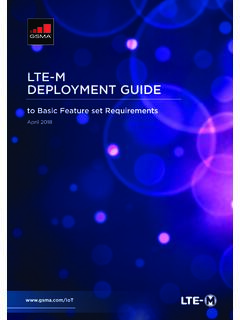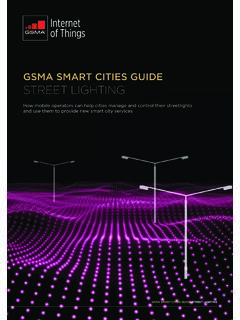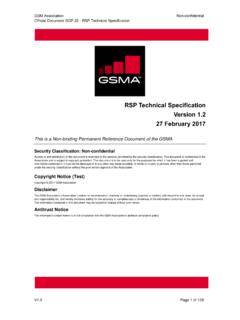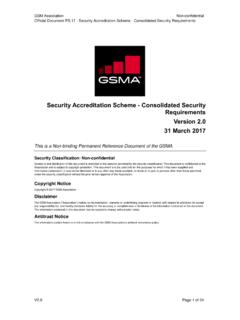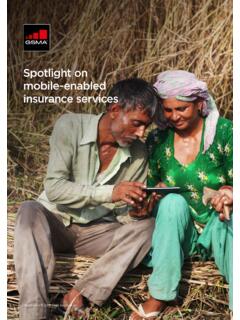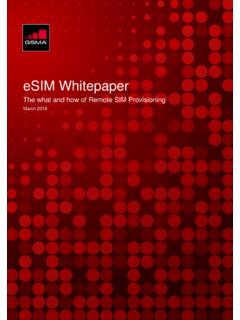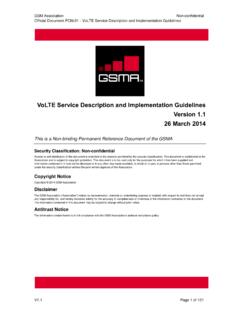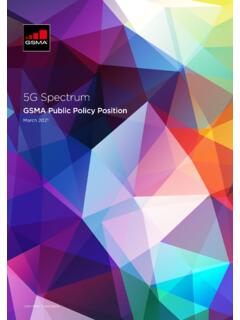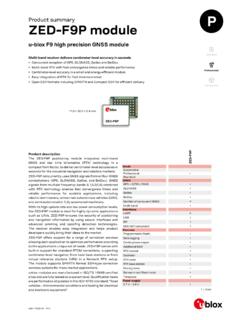Transcription of VoLTE Implementation Guide
1 VoLTE Implementation Guide July 2020 GSM Association VoLTE Implementation Guide Page 2 of 21 VoLTE Implementation Guide 1 Introduction 3 Overview 3 Scope 3 References 4 2 Business Drivers 4 Business drivers of VoLTE on Home Network 4 Business Drivers for VoLTE Roaming 5 Customer Experience 5 Coverage 5 Possible Business Case Justifications (quick bullet points) 6 3 Selecting Roaming Partners - Handsets, Coverage, and Capacity Bands 7 Frequencies 7 Handsets 8 Device based Steering of Roaming 9 4 Billing Issues 9 Comparison of QCI-based charging and APN-based charging 9 Signalling 10 Retail Presentation 10 Billing from Home Network Elements 10 Time Zones 10 5 Technical Issues Important to Roaming Managers 11 Enable / Disable IMS-APN 11 IMS Registration 11 QCI Settings 12 GBR Configurations 12 Lawful Intercept 12 Single Radio Voice Call Continuity (SRVCC) 13 Fraud Systems 13 Emergency Calling 13 eCall 14 Local Number Translation & Routing 14 Determination of Location / Time-Zone (TZ) 15 IPv4/IPv6 Compatibility Issues 15 WPS (Wireless Priority Service)
2 15 Testing Considerations 15 Annex A VoLTE Roaming Checklist 17 Annex B Summary of MME and HSS Requirements 21 GSM Association VoLTE Implementation Guide Page 3 of 21 1 Introduction Overview LTE (Long Term Evolution), with its capability and optimized architecture to provide mobile broadband services, has been adopted aggressively by operators over the world and it is now provided by over 7541 operators around the world. As LTE is an All-IP network, the voice and messaging services provided over CS (Circuit-Switched) domain in previous generations needed to be adapted and evolved to work over an LTE network. VoLTE (Voice over LTE) addresses the migration to a PS (Packet Switched) only domain by leveraging on the capabilities of the IMS (IP Multimedia Subsystem) to offer voice and messaging services over LTE.
3 In this context, VoLTE is important because it enables decommissioning of legacy CS networks as voice services can be migrated to LTE networks. Furthermore, VoLTE provides customers with enhanced voice quality, reduced time taken to establish call and the possibility of placing video calls. An important further consideration is the support of VoLTE for roaming UEs. Such capability needs to be widespread before legacy CS networks can be decommissioned. There are two competing technologies for the provision of VoLTE Roaming, namely LBO (Local Break-Out) and S8HR (S8 Home Routing). Current deployments of VoLTE Roaming are all based on S8HR. All future deployments of VoLTE Roaming are recommended to be, and indeed expected to be, based on S8HR. Scope This document provides details of commercial S8HR VoLTE roaming deployments which roaming managers may find of use as they plan and execute their first S8HR VoLTE roaming project.
4 Information provided includes business plan considerations, fraud system impacts, considerations on roaming support (handsets and frequencies), billing considerations, regulatory considerations and finally it includes a sample checklist/ questionnaire that can be used by both the HPMN and the VPMN to assess if the other MNOs network will support their roamers and to assist in configuration requirements. Technical solutions may be mentioned but their descriptions are out of scope. Rather, references to GSMA Network Group documents will be included for further information. LBO Roaming is also out of scope for this document. Note: [7] LTE Roaming Implementation Handbook covers issues related to implementing LTE, a network architecture for wireless access based on an all IP network.
5 [6] Agreements Handbook has information on adding VoLTE Roaming to the International Roaming Agreement. 1 as of January 13, 2020 GSM Association VoLTE Implementation Guide Page 4 of 21 References Ref Doc Number Title [1] 3 GPP TS IP Multimedia Subsystem (IMS) emergency sessions [2] IETF RFC 8147 Next-Generation Pan-European eCall [3] 3 GPP TS User Equipment (UE) conformance specification [4] 3 GPP TS Evolved Universal Terrestrial Radio Access (E-UTRA); User Equipment (UE) radio transmission and reception [5] GSMA PRD STIRA Common Annexes [6] GSMA PRD Agreements Handbook [7] GSMA PRD LTE Roaming Implementation Handbook [8] GSMA PRD Roaming Database Structure and Updating Procedures [9] GSMA PRD VoLTE Roaming Tests [10] GSMA PRD Guidelines for IPX Provider Networks [11] GSMA PRD IMS Roaming, Interconnection and Interworking Guidelines [12] GSMA PRD LTE and EPC Roaming Guidelines [13] GSMA PRD Emergency Communications [14] GSMA PRD TAP Test Cases for VoLTE Roaming Testing [15] GSMA PRD Implementation Handbook [16] GSMA PRD Common Billing and Charging Processes [17] GSMA PRD Billing and Charging Evolution Reports [18] GSMA PRD Device Field & Lab Tests [19]
6 GSMA PRD Technical Adaptation of Device through late customisation 2 Business Drivers This section contains information that the MNO can use in its business plan to justify launching VoLTE roaming outbound and/or inbound. Business drivers of VoLTE on Home Network VoLTE provides five benefits over traditional CS voice calls. Migration to IP. VoLTE enables operators to migrate their circuit switched infrastructure ( 3G) to a fully IP centric network. Without VoLTE , 4G networks cannot support voice service, therefore operators wishing to offer this communication capability will need to still support legacy technologies and use CSFB (CS Fallback) techniques to redirect the user towards them when a call is made or received. Voice Quality. VoLTE offers higher voice quality than legacy circuit switched voice.
7 As shown in Figure 1, VoLTE provides voice in wider range of frequency and enhances the voice quality significantly. With Implementation of EVS (Enhanced Voice Services) codec, the range is even extended, and customers can enjoy very high-quality voice. GSM Association VoLTE Implementation Guide Page 5 of 21 Figure 1 Higher voice quality offered by VoLTE Fast Call setup. Another prominent advantage of VoLTE is the shorter call setup time compared to legacy circuit switched voice services. Call setup time is the time it takes from initiating the call to hearing from or speaking to the called party, and VoLTE reduces the call setup time to about a third of that of legacy circuit switched voices. Multimedia communications. VoLTE also enables video calls to be provided in conjunction with HD voice (ViLTE: Video over LTE).
8 This means that not only video calls are possible between VoLTE subscribers, but also switching between Video and Voice is supported. Efficiency. As VoLTE calls are natively supported by LTE networks, the scarce radio resources are used much more efficiently than with legacy technologies. Business Drivers for VoLTE Roaming Customer Experience VoLTE roaming extends all the benefits mentioned in to subscribers that are roaming abroad resulting in the same user experience as at home. S8HR VoLTE roaming also unlocks two additional key benefits to subscribers: Firstly, S8HR enables exactly the same user experience as when non-roaming Secondly, voicemail is more reliable as there is no need to interwork with VPMN (Visited Public Mobile Network) and call forwarding is activated as it would be when the subscriber is at home.
9 Coverage Launching VoLTE roaming provides better coverage in two ways: New Operators - There are a number of new operators that launched with 4G only. Launching VoLTE roaming provides access to those networks for inbound roamers. Existing Partners Closing 2G and/or 3G coverage - Operators are decommissioning 2G, 3G or both to re-farm the spectrum for 4G and 5G. Some operators maintain older networks but with minimal spectrum to support IoT devices. Even if other operators maintain legacy networks, coverage is never identical leading to coverage gaps and network congestion on the remaining networks. GSM Association VoLTE Implementation Guide Page 6 of 21 Possible Business Case Justifications (quick bullet points) Operational efficiencies Fewer network elements involved for S8 Home Routed VoLTE traffic Simplified roaming agreements for VoLTE Reduced development and Implementation effort Reduced testing effort Bill shock mechanisms not impacted Fewer billing touch points Fewer IPX services associated with roaming Implementation Advantages of S8HR VoLTE Roaming The reduction in complexity of development, deployment.
10 And settlement represents a faster time to market solution Roaming architecture model is similar to existing roaming for legacy network and LTE data networks Accelerate Implementation of VoLTE Roaming worldwide Strategy/Competition Strategic objective to remain preferred roaming destination of choice for inbound roamers in relation to other competitors. Competitive Pressures in-home market Global circuit switched footprint is now in decline With the number of operators that need to launch VoLTE roaming, a late transition will mean waiting in testing queues to enable launch Revenues and Expenses Enables opportunity to expand into new roaming partner relations ( , new greenfield LTE operators), both international and domestic IoT solutions with voice (such as eCalling in Automobiles) have to plan for 10+ years in the future.
